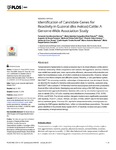Por favor, use este identificador para citar o enlazar este ítem:
http://www.alice.cnptia.embrapa.br/alice/handle/doc/1072217Registro completo de metadatos
| Campo DC | Valor | Lengua/Idioma |
|---|---|---|
| dc.contributor.author | SANTOS, F. C. dos | pt_BR |
| dc.contributor.author | PEIXOTO, M. G. C. D. | pt_BR |
| dc.contributor.author | FONSECA, P. A. de S. | pt_BR |
| dc.contributor.author | PIRES, M. de F. A. | pt_BR |
| dc.contributor.author | VENTURA, R. V. | pt_BR |
| dc.contributor.author | ROSSE, I. da C. | pt_BR |
| dc.contributor.author | BRUNELI, F. A. T. | pt_BR |
| dc.contributor.author | MACHADO, M. A. | pt_BR |
| dc.contributor.author | CARVALHO, M. R. S. | pt_BR |
| dc.date.accessioned | 2017-07-07T11:11:11Z | pt_BR |
| dc.date.available | 2017-07-07T11:11:11Z | pt_BR |
| dc.date.created | 2017-07-07 | pt_BR |
| dc.date.issued | 2017 | pt_BR |
| dc.identifier.citation | PLoS ONE, v. 12, n. 1, 2017. | pt_BR |
| dc.identifier.uri | http://www.alice.cnptia.embrapa.br/alice/handle/doc/1072217 | pt_BR |
| dc.description | Temperament is fundamental to animal production due to its direct influence on the animal-herdsman relationship. When compared to calm animals, the aggressive, anxious or fearful ones exhibit less weight gain, lower reproductive efficiency, decreased milk production and higher herd maintenance costs, all of which contribute to reduced profits. However, temperament is a trait that is complex and difficult to assess. Recently, a new quantitative system, REATEST®, for assessing reactivity, a phenotype of temperament, was developed. Herein, we describe the results of a Genome-wide association study for reactivity, assessed using REATEST® with a sample of 754 females from five dual-purpose (milk and meat production) Guzerat (Bos indicus) herds. Genotyping was performed using a 50k SNP chip and a two-step mixed model approach (Grammar-Gamma) with a one-by-one marker regression was used to identify QTLs. QTLs for reactivity were identified on chromosomes BTA1, BTA5, BTA14, and BTA25. Five intronic and two intergenic markers were significantly associated with reactivity. POU1F1, DRD3, VWA3A, ZBTB20, EPHA6, SNRPF and NTN4 were identified as candidate genes. Previous QTL reports for temperament traits, covering areas surrounding the SNPs/genes identified here, further corroborate these associations. The seven genes identified in the present study explain 20.5% of reactivity variance and give a better understanding of temperament biology. | pt_BR |
| dc.language.iso | eng | eng |
| dc.rights | openAccess | eng |
| dc.subject | Temperament traits in cows | pt_BR |
| dc.subject | Temperament biology | pt_BR |
| dc.subject | Cattle temperament | pt_BR |
| dc.title | Identification of candidate genes for reactivity in Guzerat (Bos indicus) cattle: a genome-wide association study. | pt_BR |
| dc.type | Artigo de periódico | pt_BR |
| dc.date.updated | 2017-07-07T11:11:11Z | pt_BR |
| dc.format.extent2 | 15 p. | pt_BR |
| riaa.ainfo.id | 1072217 | pt_BR |
| riaa.ainfo.lastupdate | 2017-07-07 | pt_BR |
| dc.contributor.institution | Fernanda Caroline dos Santos, UFMG; MARIA GABRIELA CAMPOLINA D PEIXOTO, CNPGL; Pablo Augusto de Souza Fonseca, UFMG; MARIA DE FATIMA AVILA PIRES, CNPGL; Ricardo Vieira Ventura, Center for Genetic Improvement of Livestock, University of Guelph, Guelph, Canada; Izinara da Cruz Rosse, UFMG; FRANK ANGELO TOMITA BRUNELI, CNPGL; MARCO ANTONIO MACHADO, CNPGL; Maria Raquel Santos Carvalho, UFMG. | pt_BR |
| Aparece en las colecciones: | Artigo em periódico indexado (CNPGL)  | |
Ficheros en este ítem:
| Fichero | Descripción | Tamaño | Formato | |
|---|---|---|---|---|
| Cnpgl2017PlosOneSantosIdentification.pdf | 1.5 MB | Adobe PDF |  Visualizar/Abrir |









